Utah says the White Mesa Mill isn’t contaminating groundwater, but its neighbor, the Ute Mountain Ute Tribe, disagrees.
On a warm July evening, Yolanda Badback described the noxious fumes that haunt the air where she lives. Unlike the fragrance of sagebrush or the sweet scent of juniper and piñon, the odor is astringent and sulfuric, hard to breathe. Sometimes it forces Badback and her family of eight to stay indoors. At its worst, it causes nausea.
Badback lives in White Mesa, Utah, on part of the Ute Mountain Ute Reservation. The smell comes from her neighbor, the White Mesa Mill, the last conventional uranium mill in the United States. When the mill’s tall smokestacks begin to billow and the winds roll off the blue Abajo Mountains, the stench floats five miles south to White Mesa. Badback, like most residents, can smell it from her doorstep.
Badback sat on a gray couch, hugging a pillow to her chest, her long black hair pulled into a loose ponytail. A retired health representative for the tribe, she has devoted her life to closing the mill. Badback’s mother, Ute Mountain Ute elder Thelma Whiskers, sat next to her, switching between English and the Ute language whenever her great-grandchildren peered through the doorway or came into the room.
“A lot of people don’t understand what we go through here in our community,” Badback said. “We want the mill to close. We want them to clean it up.”
Badback sounds frustrated and fatigued; at 48, she barely remembers life without the mill. Over the past 40 years, the construction of the mill demolished archaeological and burial sites important to the Ute Mountain Ute Tribe and depleted the tribe’s traditional hunting grounds, destroying places where people once gathered plants for basketry and medicine. Radioactive waste has been spilled along the main highway from trucks hauling material from Wyoming to White Mesa for processing. The children can no longer play outside because of the stench and the fear of what might be causing it.

The mill sits in the heart of San Juan County, a few miles east of the original boundaries of Bears Ears National Monument, with Canyonlands National Park to the north and Monument Valley to the southeast. It opened in 1980 to process uranium ore from the Colorado Plateau into yellowcake, a concentrated powder used in energy production and nuclear weapons. Most uranium mines closed in the last half-century. But White Mesa not only remains open, it has become a destination for radioactive material from around the world. Now, its owners want to accept waste from the Northern European country of Estonia, nearly 5,000 miles away.
Underneath the mill lies the shallow Burro Canyon aquifer, which feeds the sacred freshwater springs the tribe relies on. A layer of sandstone and shale separates it from the deeper Navajo Sandstone aquifer, White Mesa’s primary source of drinking water. The Navajo Sandstone aquifer empties into the San Juan River, one of the Colorado River’s main tributaries. Data from Energy Fuels Resources, the Colorado-based company that owns the mill, shows that groundwater from the Burro Canyon aquifer contains multiple contaminants — and that it’s rapidly getting worse. The company blames naturally occurring contaminants or previous industries, even as the contamination keeps growing.
Now, both the tribe and conservationists fear that if Energy Fuels Resources is allowed to import Estonia’s waste, it will not only further endanger the tribe, it will encourage more radioactive byproducts to be imported, prolonging the life of the mill and its impacts on land, air, water and the community’s cultural heritage. “At which point will somebody say, ‘Enough’?” Peter Ortego, the tribe’s general council spokesperson, said to me. “The tribe has already said, ‘Enough,’ and we wish other people would join us.”
“The tribe has already said, ‘Enough,’ and we wish other people would join us.”
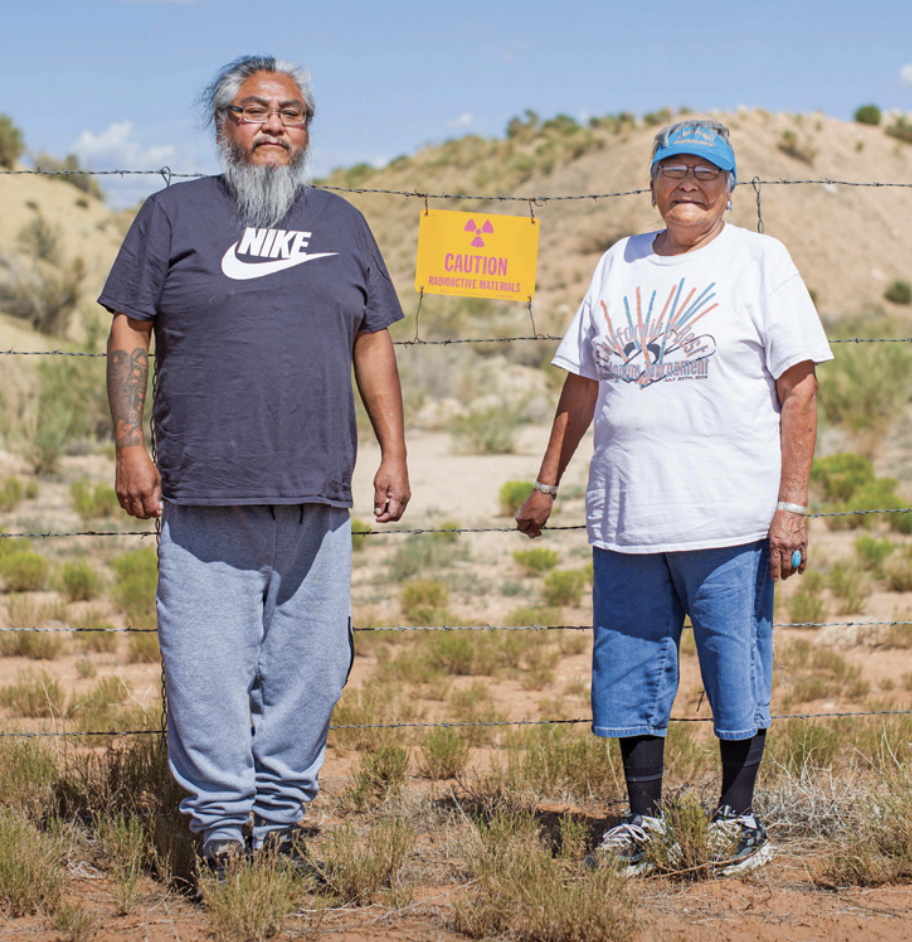
AS TENSE AND HUMID summer monsoon clouds formed over the mesa, Michael Badback, Yolanda’s brother, drove me around in his nephew’s black Ram truck. We started on the mill’s west side and drove north along a dirt road, following the mill’s boundaries. Badback pointed out a small cluster of buildings and warehouses. Tribal members used to hunt deer and rabbits in this area, he said, and gather the once-lush sagebrush for medicinal tea.
“The sagebrush used to look like turquoise,” Badback said. “And now, you see them, and they’re all dead.”
Badback no longer hunts here. Only a 4-foot-tall barbed wire fence, marked with radioactive warning signs but riven by large gaps, separates the mill from the hunting grounds. The mesa’s wildlife has easy access to the mill’s five “tailings cells” — pits that hold a poisonous soup of radioactive slurry and toxic waste, leftovers from the uranium-milling process.
Today, the tailings cells cover about 290 acres — the equivalent of 382 football fields. When the mill was first built in 1980, three cells were constructed, with only a single layer of lining to separate the toxic waste from the ground and no leak-detection systems. If it were built today, all the cells would require two layers of liners and a system to detect any leakage.
Badback told me that hunters in the community said they’d seen deer hop the fence and drink from the tailings ponds; some animals have been found with green-colored meat. Now, tribal members travel great distances to hunt and collect herbs safely.
This wasn’t always the case. For thousands of years, Badbacks’ ancestors called the Four Corners region home. Yolanda and Michael’s mother, like the generations before her, gathered willows for weaving baskets, sagebrush for tea and sumac berries on the open mesas and desert ridges. People hunted deer and elk, and grew squash, corn and beans. The sandstone landscape is dotted with archaeological sites, including kivas, pit houses, petroglyphs and burials.

Life changed dramatically for the Ute Mountain Ute and other Four Corners tribes — the Hopi, Diné, Ute and Pueblo of Zuni — when the Spanish colonized the area, and were eventually followed by Mormon settlers. Through a series of land cessions and treaties in the late 1800s, the U.S. government drastically reduced the tribe’s ancestral land claims and forced most of its members to move to a reservation in western Colorado, though a few obtained small allotments in San Juan County, Utah. Today, the Ute Mountain Ute Tribe is split between two locations: About 2,000 people live in Towaoc, Colorado, the tribe’s headquarters, while a smaller community of about 300 live in White Mesa.
The lands the U.S. government chose as reservation sites were often remote and rugged, regarded as undesirable by white settlers. But as Stephanie Malin, an associate professor of sociology at Colorado State University and the author of The Price of Nuclear Power: Uranium Communities and Environmental Justice, explained, many of those “undesirable” lands later turned out to be rich in coal, natural gas and, especially, uranium. Suddenly, extractive industries were interested. Uranium mills and mines were built near or on tribal lands; the Jackpile-Paguate Uranium Mine on Laguna Pueblo land, for example, was once one of the largest open-pit uranium mines in the world.
Mining and milling increased rapidly after World War II, once the Cold War began, mostly on the Colorado Plateau, which was home to some of the nation’s largest uranium deposits. Until 1971, the federal government was the sole purchaser of uranium ore in the U.S., and it relied heavily on Indigenous — especially Navajo — labor for mining.
Over 90% of all milling in the U.S. occurred on or just outside reservation boundaries. According to the Environmental Protection Agency, there are more than 500 abandoned uranium mines on the Navajo Nation alone. All that mining has compromised the health of the Southwest’s Indigenous people.
European experience earlier in the century had shown that exposure to uranium had potentially fatal health effects. But the U.S. industry was loosely regulated, and the few regulations that existed were largely unenforced. Little protection was provided for miners.
Today, federal and state governments have regulations concerning environmental protection, worker health and safety, and treatment of contaminated sites. But the regulations lack uniformity, and the responsibility for enforcement is spread across multiple agencies. In 1974, the U.S. government created an independent agency, the Nuclear Regulatory Commission (NRC), to regulate nuclear power plants and other uses of nuclear materials.
The White Mesa Mill opened in 1980 under NRC regulation. An environmental assessment done at the time estimated its lifespan at 15 years, leading the tribe and many other locals to believe it would be a relatively short-lived enterprise, and that reclamation would begin shortly after operation ceased. A few years later, the Utah Department of Environmental Quality’s Division of Waste Management and Radiation Control took over regulatory oversight from the NRC.
Instead of closing after 15 years, the mill started to process “alternate feed” — uranium-laden waste from contaminated sites across the country — in the early ’90s, including from the Oklahoma Sequoyah Fuels plant near Gore, Oklahoma. The White Mesa Mill processed tens of thousands of tons of radioactive waste from other mills for small amounts of uranium and stored the resulting waste in its tailings ponds, a practice that continues today.
According to Kamran Zafar, former staff attorney for the environmental nonprofit Grand Canyon Trust, this practice exploits a regulatory framework that classifies radioactive byproducts as “alternate feed” rather than conventional uranium ore. Because radioactive byproducts are classified this way, the mill can receive and process them despite the fact that it has to store the leftover materials. More than 99.73% of the shipped material from Estonia will be stored at White Mesa.
“(Energy Fuels Resources) say they’re recycling the alternate feed, which basically means they’re getting out the trace amounts of uranium that are left that other disposal facilities couldn’t,” Zafar told me. “But really what they’re doing is they’re getting paid to dispose of the vast majority of that waste at the White Mesa Mill permanently. And because they’re not a properly licensed radioactive waste facility, they can do it at much cheaper cost than other facilities could.”
Curtis Moore, Energy Fuels Resources’ vice president of marketing, disagrees. “We get license amendments pursuant to state and federal law — it’s not some obscure loophole,” he said.

The company wants to import 2,000 drums — 615 metric tons — of radioactive waste from Estonia, which has no licensed facilities capable of processing its waste. First, however, the company had to amend its radioactive material license. Utah’s Division of Waste Management and Radiation Control received a huge volume of public comments once people learned about it — nearly 12,000 of them opposed, compared to only around 300 in support. Still, it granted Energy Fuels Resources’ request this summer.
Both the tribe and environmental watchdogs are worried about the quality and longevity of the older tailings cells, concerned that they’ll leak into the aquifers below — if they haven’t already.
“These three older cells have been there for 40 years, and they were not designed to be there for 40 years,” Scott Clow, the environmental programs director for the Ute Mountain Ute Tribe, told me. Clow believes, “It’s not whether they leak, it’s how much they leak.”
“It’s not whether they leak, it’s how much they leak.”
Energy Fuels Resources, which bought the mill in 2012, has already reported that one of its cells emitted more radon into the air than allowed in 2012 and 2013 according to court records. The EPA identifies radon as the number one cause of lung cancer in nonsmokers. In 2014, the Grand Canyon Trust sued Energy Fuels Resources in Utah District Court, alleging that the company was violating the Clean Air Act. After three years of litigation, the judge ruled in the company’s favor. Three state regulators filed declarations in support of the company.
No one was surprised; Energy Fuels Resources is an influential power among government agencies and top officials. In 2017, a Washington Post investigation revealed that the company had urged the Trump administration to shrink Bears Ears National Monument, saying this would allow the industry access to uranium deposits. In a letter to the Interior Department, Mark Chalmers, the company’s president and CEO, said that the monument could impact future mill operations. “There are also many other known uranium and vanadium deposits located within the (original boundaries) that could provide valuable energy and mineral resources in the future,” he wrote.
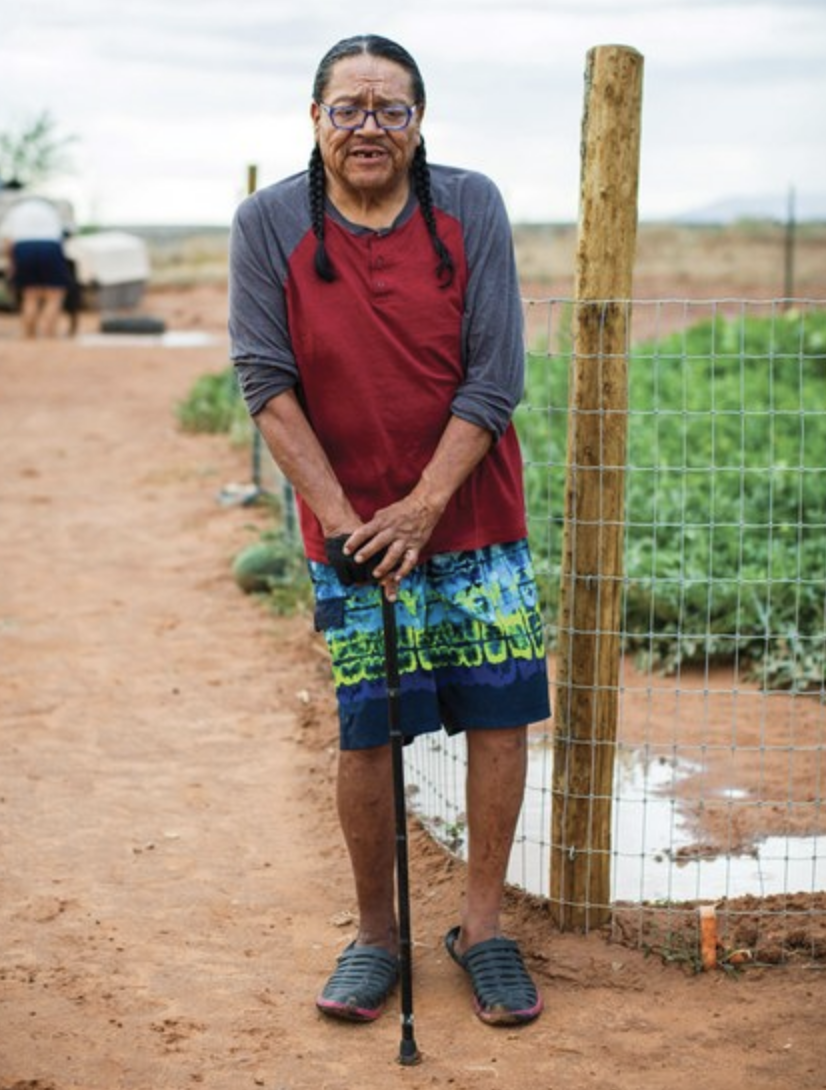
ALDEAN BETCHUM,a Ute Mountain Ute elder, professional flute player and Bear Dance chief, has noticed the changes to the land. His great-grandfather and the generations before him were sheepherders in and around the greater Bears Ears region. As a young boy, Ketchum was responsible for his grandfather’s sheep. Every summer, he rose early to corral about a hundred animals, guiding them north toward Elk Ridge along Cottonwood Wash, an important tributary to the San Juan River, leading them toward the freshwater springs.
“That’s how my people survive,” Ketchum said. “Over the years and even through the Depression, we were out there, surviving and living off of the land.”
But now, vegetation near the mill is drier than it used to be, the springs are at risk of contamination and the water that flows from the pipes of homes like Ketchum’s tastes metallic. “There was a time when we lived and our water that we had here was so delicious and so sweet, you’d drink it all day,” Ketchum said. Today, like most locals, Ketchum either boils his water before drinking it or travels great distances to purchase water in bulk.
Groundwater monitoring on the mill’s property has increased since the late ’90s, but public data collected from Energy Fuel Resources’ monitoring wells and processed by tribal scientists reveal that contamination has gradually worsened. Starting in the late ’90s, some plumes — a release or movement of contaminants in the groundwater — were detected beneath the mill. One of them was a chloroform plume, which was identified as laboratory waste left over from previous activity. However, a nitrate/chloride plume was also identified, and data has shown the groundwater is contaminated with multiple heavy metals, including uranium.
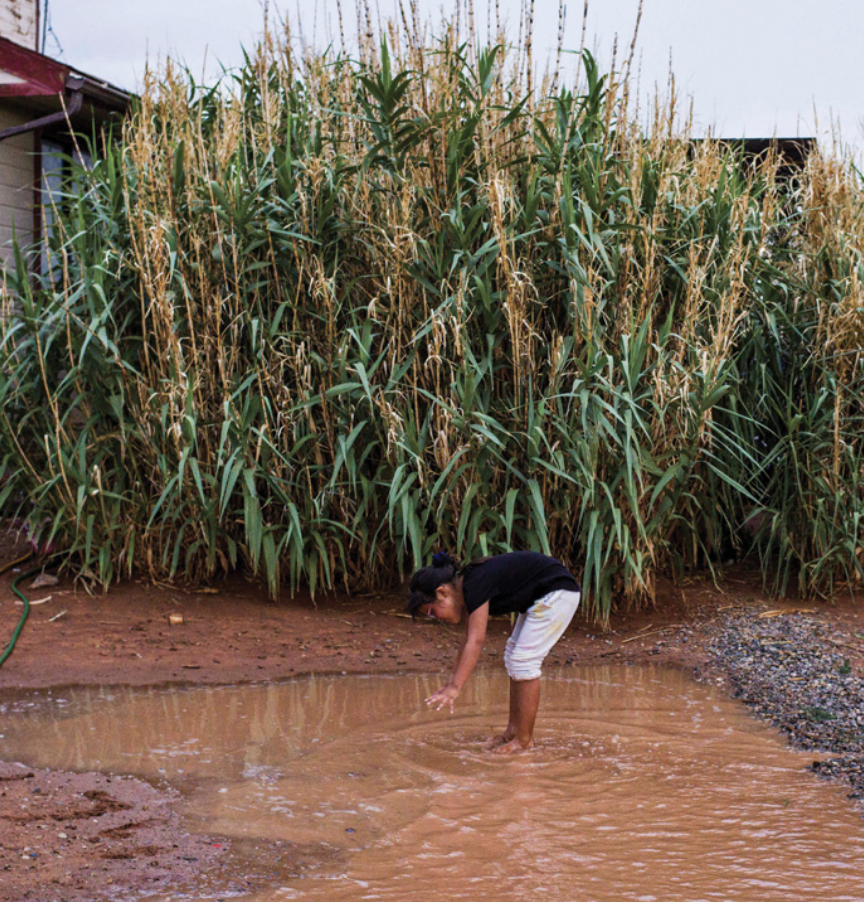
All the while, groundwater is becoming more acidic. Normal drinking water possesses a pH level between 6.5-8.5, but data from the tailings cells shows pH levels between 1-3, with one of the oldest cells possessing a pH level less than 1 as recently as 2020. Significant lowering of pH has been seen in groundwater plumes associated with other contaminated uranium mill sites, such as the Bear Creek uranium mill in Wyoming.“We’ve gone from no data indicating groundwater contamination, to some data indicating groundwater contamination, to a lot of data indicating groundwater contamination,” Clow, the tribe’s environmental programs director, told me.
Energy Fuels Resources contends that the pollution is related to changes in the geochemistry or previous industrial activities that occurred on the property. “There’s no evidence that there’s any leaking or anything happening at those sites that I’m aware of, so (we’re) certainly not contaminating the groundwater of the Utes or whatever,” Moore, the company’s vice president of marketing, told me. “We’re in full compliance with all laws and regulations, so you know, there’s been no adverse environmental or health impacts from the mill that we’re aware of.”
The state says that there’s no proof that any cells have leaked. “You can have natural rising trends, a decrease in trends that could basically be from changes in concentration of pH in the wells, but also could just be, you know, some years you have more water and less water,” Phil Goble, uranium mills and radioactive materials manager at the Utah Division of Waste Management and Radiation Control, said. “Depending on what the elevation is for the groundwater, it can change some position with concentrations that naturally happen.”
Meanwhile, the state — at Energy Fuels Resources’ request — continues to move the goalposts for acceptable contamination. When any of the several monitoring wells exceeds the levels allowed, the company is required to determine the source of the contamination and report it to the state. Since Energy Fuels Resources bought the White Mesa Mill, it has requested modifications to groundwater compliance levels, often increasing the level permitted, at least 27 times in the past nine years. The Utah Division of Waste Management and Radiation Control has granted all its requests, occasionally asking for more data analysis. “If the licensee can meet the criteria that’s outlined in federal and state law, we’re obligated to say yes, we can’t legally say no,” Goble said.
In a letter to the Utah Division of Waste Management and Radiation Control in 2020, the Ute Mountain Ute raised concerns about the contamination in several wells on the mill’s property. The tribe pointed out seven instances near the end of 2019, when wells exceeded contamination levels. The tribe urged the state to investigate and “identify and address the root causes of the contamination, rather than artificially relaxing groundwater contaminant levels (GWCLs) to excuse noncompliant data and allow further degradation of water quality.”
The state says it takes the tribe’s concerns seriously. However, it sides with Energy Fuels Resources. “We understand the concerns of Ute Mountain Ute Tribe, but based off of what we’ve seen over the past 16, 17 years of regulating the White Mesa Mill after receiving it from the NRC, we have no evidence to support any kind of assertions the mill is harmful to human health or the tribe,” Goble said. “We can definitely understand their concerns, but we haven’t seen anything that says the mill is harming the members of the tribe.”
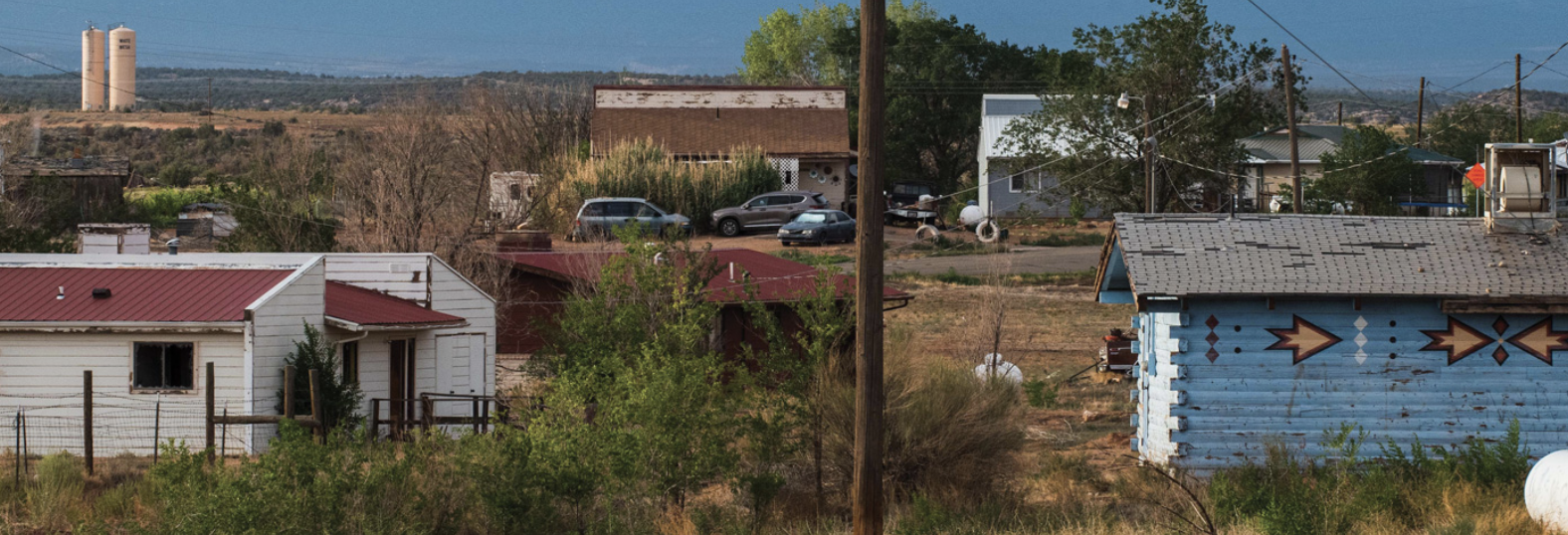
“We’ve been telling the state that if they really believe that this formation is naturally acidifying and releasing contaminants to toxic levels … that’s a big deal, and they should be studying this and alerting people.”
Even if the contaminants were naturally occurring and the mill was not contributing to groundwater pollution, the state should be monitoring it closely, Colin Larrick, the tribe’s water quality program manager, said. “We’ve been telling the state that if they really believe that this formation is naturally acidifying and releasing contaminants to toxic levels … that’s a big deal, and they should be studying this and alerting people,” he said. “But there’s none of that.”
On a hot morning in July, Larrick showed me some of the tribe’s monitoring wells. We drove north along Highway 191 and turned west onto a gravel road about a mile south of the mill. He stopped about a hundred feet from the highway and pointed to a 2-foot-high square yellow structure. It’s small and easily overlooked, but its importance is sizable: It is the tribe’s latest monitoring well, placed on Bureau of Land Management land as close as possible to the mill’s boundaries. The well’s location will enable the tribe to better track any changes to the groundwater closer to the reservation, and to compare that data to the information the mill is obtaining from its own wells.
As we drove on, the gravel road turned to rust-colored dirt, dampened by yesterday’s monsoon rains. As we descended from the flat mesa, junipers began to appear in greater numbers, cottonwood trees emerged, and the vegetation glowed a brighter green, indicating that water was nearby. Below the mesa, a spring brought freshwater to the desert, not in a gushing surge, but in a slow and steady trickle. Small droplets fell from the porous rock above the spring, and a sliver of a stream, about the width of a pencil, flowed out of the rock into the ravine. Steep cliffs rose above it. At the top, there were remnants of Puebloan structures: The water had clearly been relied on for thousands of years.
This freshwater spring is important to the Ute Mountain Ute, who use it for drinking water, sweat lodges and ceremonial purposes. This spring and others in the area have maintained a steady flow and good quality water for decades, but Larrick and the tribe worry that contamination from the mill could soon change that. In the meantime, Larrick said, “These are the standards that we aim to protect these resources; that’s the type of use we expect springs to support into the future.”
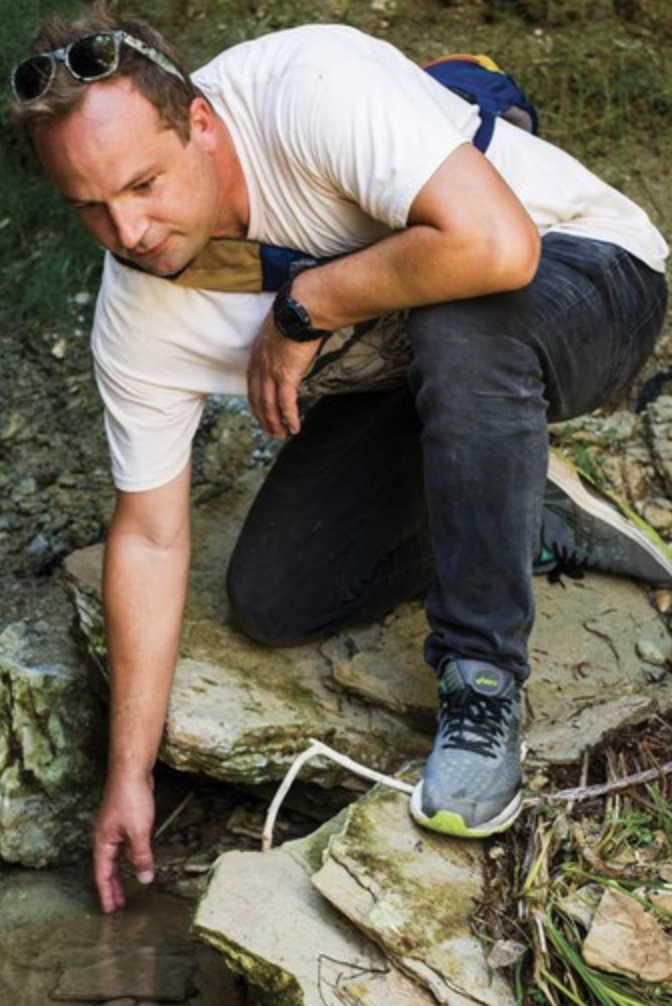
In addition to amending its license, Energy Fuels Resources plans to build two more tailings cells. The Utah Division of Waste Management and Radiation Control has yet to grant the company permission to expand, but the possibility concerns the Ute Mountain Ute. The mill is in the White Mesa archaeological district, which is home to hundreds of Ancestral Puebloan and sacred archaeological sites. Many of them are hard to distinguish owing to erosion caused by weather, cattle and farming.
When the mill was first proposed in the late ’70s, its original owners had to comply with the National Historic Preservation Act. Archaeologists had to survey the property, identify any cultural sites and suggest mitigation strategies to reduce the impacts of construction. They discovered large pit houses and kivas, storage structures, burial sites, fire pits, middens and numerous artifacts. Despite the survey, however, officials with the Ute Mountain Ute Tribe say they were not consulted, and most of the sites were destroyed during construction. Photos show bulldozers destroying what appears to be a kiva. “It’s a terrible photograph, and it just brings tears to your eyes,” Ortego, spokesman for the tribe’s general council, told me.
The tribe fears that if Energy Fuels Resources is allowed to construct new cells, more cultural sites will be lost. The company has continued to excavate on the property, but according to Terry Knight, the tribe’s historic preservation officer, the tribe has rarely been notified of any archaeological findings.
According to a Cultural Resources Easement Agreement from 1985, the BLM was aware of the archaeological sites when it first transferred the land to Energy Fuels Resources’ predecessors. The BLM’s Moab District was supposed to inspect them every three years, at least, in order to monitor and mitigate any damage. The proposed locations for the new cells include some or all of the same BLM land.
“The Bureau of Land Management has a trust responsibility for the protection of those cultural resources,” Clow, the tribe’s environmental programs director, told me. But when High Country News asked the BLM to confirm that the required inspections were being carried out, the agency declined to comment despite public records that indicated the BLM was aware of its responsibility back in 2004 and referred HCN to the Utah Division of Waste Management and Radiation Control. HCN has obtained some public records from the BLM and the Utah agency, but none of them show that any archaeological surveys were performed after 1985.
“The Bureau of Land Management has a trust responsibility for the protection of those cultural resources.”
THE FIGHT TO CLOSEWhite Mesa Mill has been a multigenerational journey for Yolanda Badback and her family. As a young girl, she accompanied her uncle, Norman Begay, to meetings where he and other tribal members spoke out against the mill, fearing it would contaminate their water, land and community. After his death, Badback and her mother, Thelma Whiskers, formed a group called White Mesa Concerned Community to educate their neighbors about uranium, which can cause both short-term and long-term health problems, including lung cancers, kidney problems, birth defects and miscarriages.
Meanwhile, the mill continues to affect the community of White Mesa, disturbing the landscape and possibly impacting the locals’ health. Badback has witnessed it all: the smokestacks, the changing water, the mining trucks that speed by, the death of the vegetation. Over the years, she has attended public hearings and testified before county commissioners and lawmakers from Blanding to Salt Lake City, arguing that the mill needs to be shuttered and the land reclaimed. She is often one of the few to speak up in town halls full of people from the nearby town of Blanding, many of whom support the mill or have jobs there. At times, Badback’s efforts have been met with furious opposition, and she’s been accosted and harassed while grocery shopping in Blanding.
But Badback and other tribal members are determined to keep fighting, submitting public comments, writing letters to the Utah DEQ, and holding an annual protest, marching from the White Mesa community center to the gates of the White Mesa Mill. Most recently, the tribe filed petitions to review and to intervene against the amendment to Energy Fuels Resources’ radioactive waste license. One day, they hope, the mill will be gone and cleaned up, and future generations will be able to thrive in the landscape their ancestors knew thousands of years ago.
Beyond its impacts on the Ute Mountain Ute, the mill’s critics say its story illustrates the enduring legacy of environmental racism, as well as the ways that Indigenous communities have been exploited by extractive industries. According to the EPA, there are 15,000 abandoned uranium mines scattered across 14 Western states, mostly Colorado, Utah, New Mexico, Arizona and Wyoming. About 75% of those mines are on federal and tribal lands.
“These companies, even the government, identify poor, brown, Black communities and intentionally pollute us, knowing that they capitalize off of it. This has a direct impact on the psyche of Native peoples,” Talia Boyd (Diné), the cultural landscapes manager for Grand Canyon Trust, said. “Because these are sacred places, these are places where we go to heal, these are places where we go to gather medicine. When it’s compromised by radioactive contaminants or contamination, then we are exposed, (because) it compromises the integrity of our landscape to heal us.”
As for Badback, she has made her position clear. “I will stand my ground,” Badback told me. “I will not stop until the day that I get this mill to close and get it cleaned up.”
Jessica Douglas is a staff writer at High Country News and a member of the Confederated Tribes of Siletz Indians. We welcome reader letters. Email her at jessica.douglas@hcn.org or submit a letter to the editor. See our letters to the editor policy.